
Nutrition
An interdisciplinary (physiology, oncology, etc.) science that studies food and health with a focus on the nutrient and chemical properties of food.
How long can you survive without food/water?
Food: weeks-month (based on body mass)
Water: ~3 days
Food security
Access at all times to sufficient supply of safe, nutritious food (don't have to scavenge or steal food)
Food insecurity
Limited or uncertain availability of safe, nutritious foods - or inability to acquire them in socially acceptable ways.
What are some risks to food insecurity?
- Poor quality diet
- Greater risk of chronic disease
What may cause food insecurity?
- poverty
- absence of supermarkets
- access to inexpensive, high calorie (low nutrition) foods
- limited cooking facilities
Where is food insecurity highest in Canada?
The north west territories (Nunavut)
*Large racial disparities in food insecurity (POC and indigenous)
What are calories

- A unit of measure that represents the amount of energy supplied by food
- Noted in kilocalorie (Kcal, C)
Nutrients
Chemical substances used by the body
- Help sustain growth and development
What are the 6 categories of nutrients?

1. Carbohydrates (CHO)
2. Protein
3. Fat
4. Vitamins
5. Minerals
6. Water
What are the 3 energy nutrients?
Carbohydrates (CHO), protein, fat
What do we eat too much/too little of in Canada?
Too much: fat, sugar, white flower, salt, preservatives, food colouring
Too little: vitamins, minerals, fiber, protein, amino acids, phytonutrients, antioxidants
Inadequate intake of vitamin A
- reduced liver stores, blood levels
- impaired ability to see in dim light
- long term: lead to loss of vision
High intake of vitamin A
- hypervitaminosis A (500,000 IU or 50,000 IU long term)
- nausea, irritability, blurred vision, headache
- liver damage
- birth defects
Dietary Reference Intakes (DRI)
Tells us the recommended amount of nutrients
Estimated Average Requirement (EAR)
average daily intake level estimated to meet the needs of half the people in a certain group. Used to calculate the RDA
Recommended Dietary Allowance (RDA)
average daily intake level estimated to meet the needs of nearly all people in a certain group. Aim for this amount!
Tolerable upper intake level (UL)
the highest average daily intake level likely to pose no health risks. Do not exceed this amount on a daily basis!
What are the 3 nutritional deficiencies?

1. Under consumption = developing nations (not enough nutrients) (e.g. famine)
2. Over consumption = typical Western diet (contributes to obesity)
3. Under nutrition = from refined foods, lack of micronutrients (bad quality)
What are some groups of people that are at higher risk of becoming malnourished?
- infants
- pregnant people
- elderly
- ill or recovering from illness
Can poor nutrition influence the development of certain chronic diseases?
YES!
- high blood pressure
- kidney failure
- heart attack
- colon cancer
etc.
What does Canada's food guide look like?
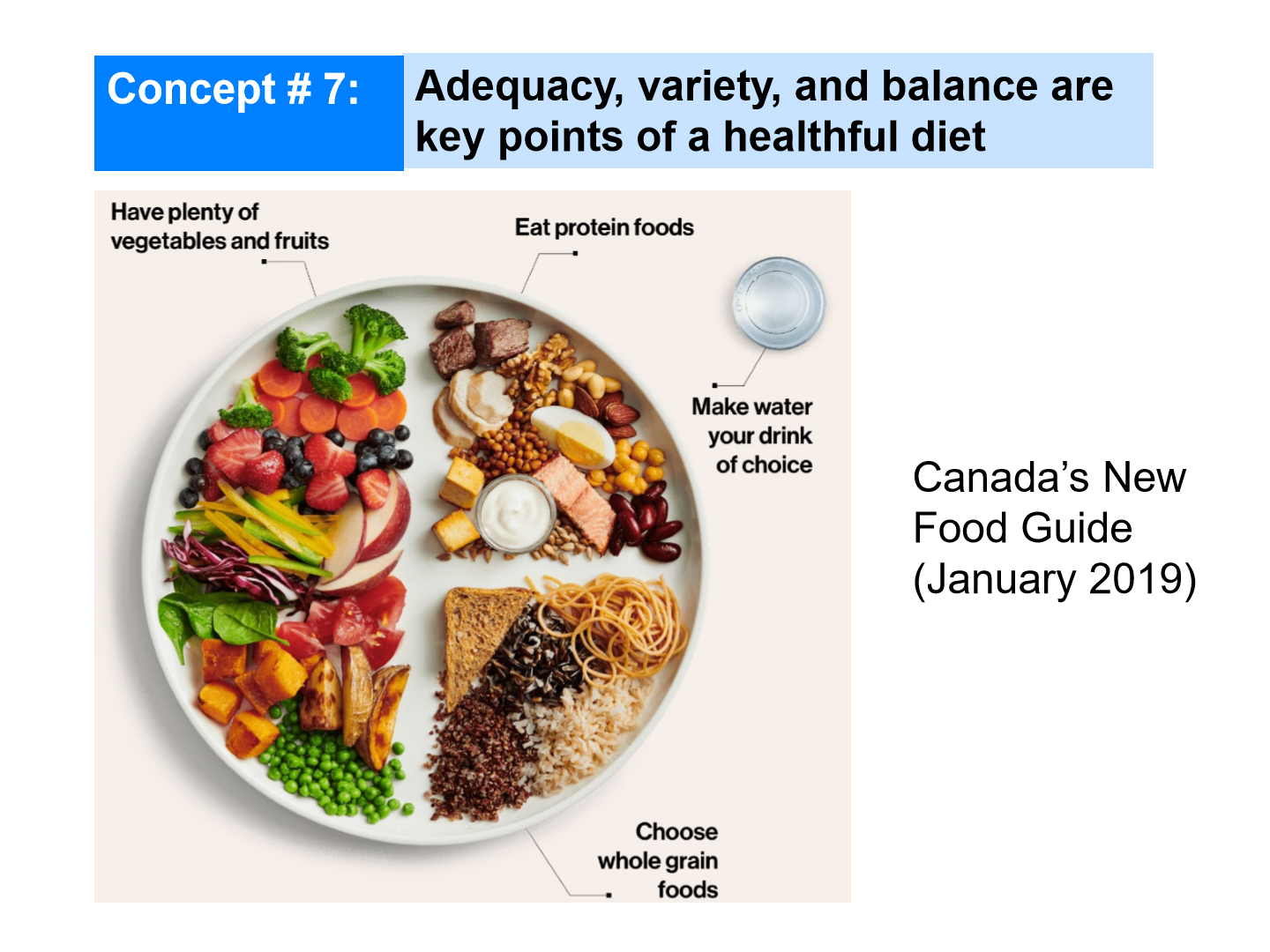
What are 3 key points of a healthy diet?
- adequacy
- variety
- balance
Are there good or bad foods?
NO!
Orthorexia nervosa
– Unhealthy fixation with eating healthy
– Can lead to nutritional deficits
– No specific category in DSM (Diagnostic & Statistical Manual) butfalls under Avoidant/Restrictive Food Intake Disorder (ARFID)
Questions to ask:
- Do you feel guilt or self-loathing when you stray from your diet?
- Are you constantly looking for ways foods are unhealthy for you?
- Do you feel in control when you stick to the “correct” diet?
- Have you put yourself on a nutritional pedestal and wonder how others can possibly eat the foods they eat?
- Does it seem beyond your ability to eat a meal prepared by someone else and not try to control what is served?
What are some conditions that contribute to death among adults under 75?
Health care: 10%
Environmental exposures: 20%
Lifestyles: 51%
Genetic makeup: 19%
Risk factors
A condition or behavior associated with an increased frequency of a disease but not proved to be causal.
What are some risk factors?
– Dietary
– Genetics
– Age
– Sedentary lifestyle
– Smoking and tobacco use
– Stress
– Environmental contaminants
What are the 3 highest mortality rates attributed to diet?
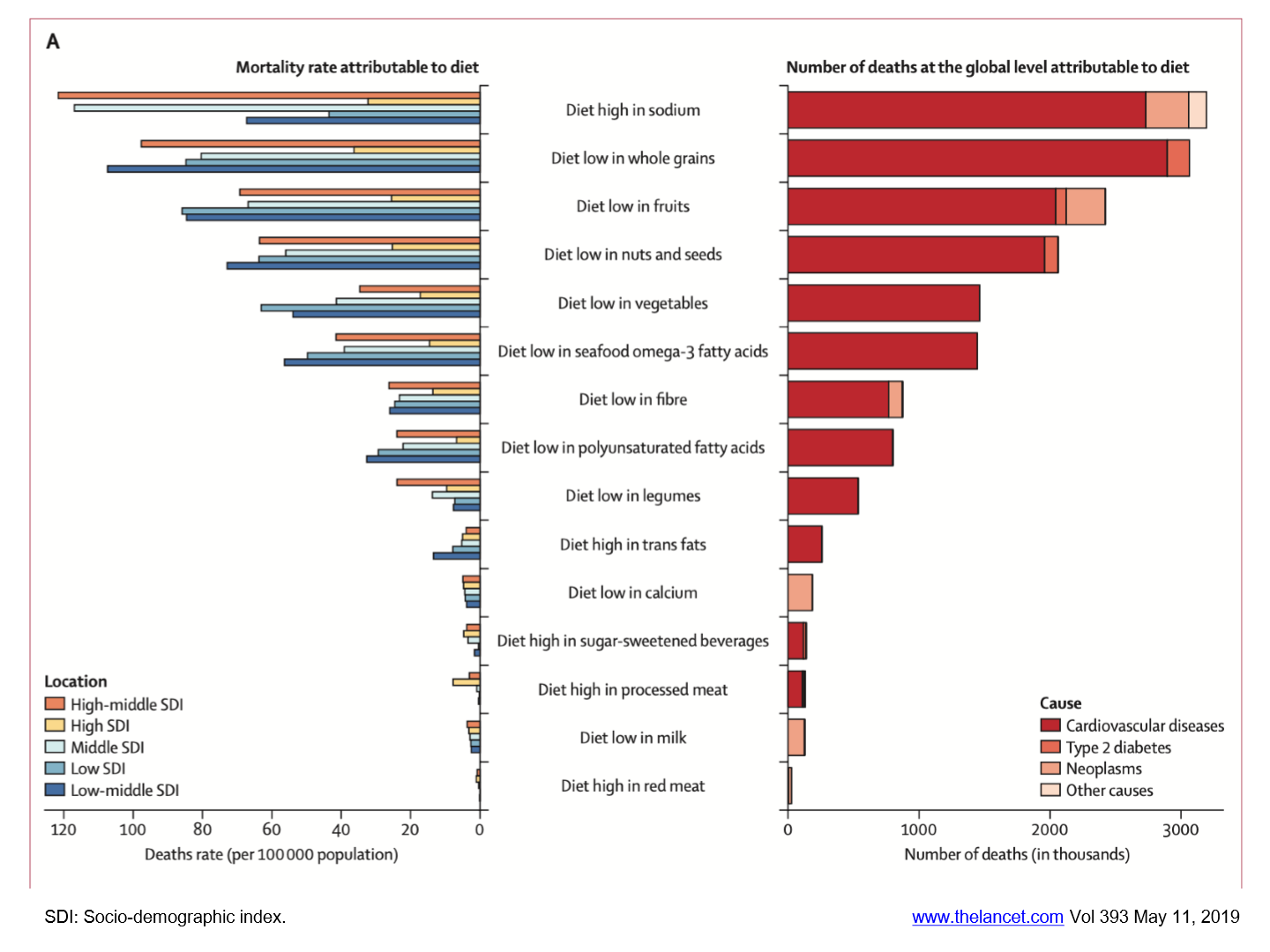
1. Diet high in sodium
2. Diet low in whole grains
3. Diet low in fruits
How do Western diets promote chronic diseases?
• Diets high in salt, refined grains (e.g. white flour), processed meats, refined sugars (e.g. white sugar)
• Diets low in fruits, vegetables and fiber
Top causes of death in the US
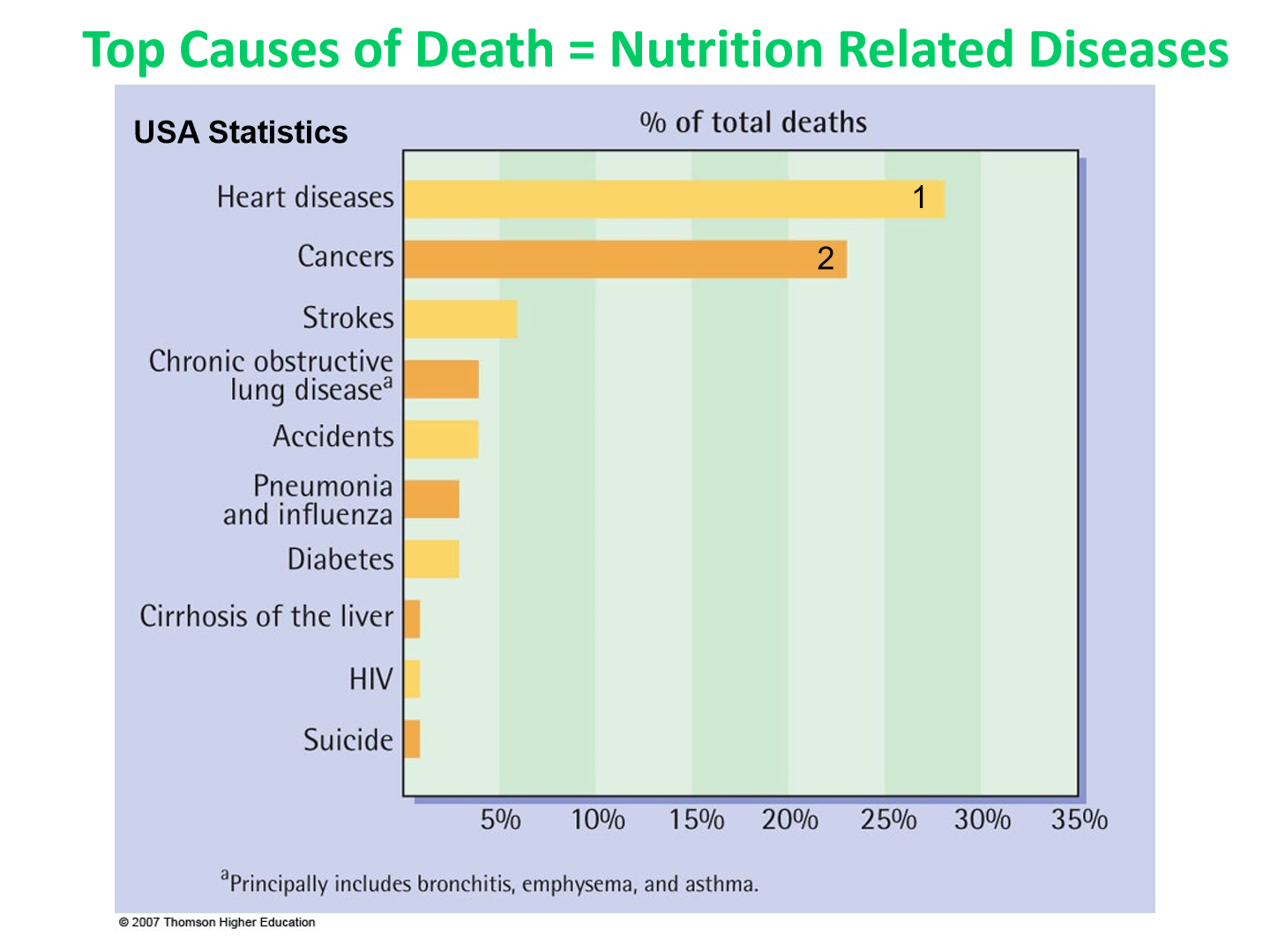
1. Heart disease
2. Cancers
3. Strokes
*nutrition related diseases
Leading death in Canada, 2019
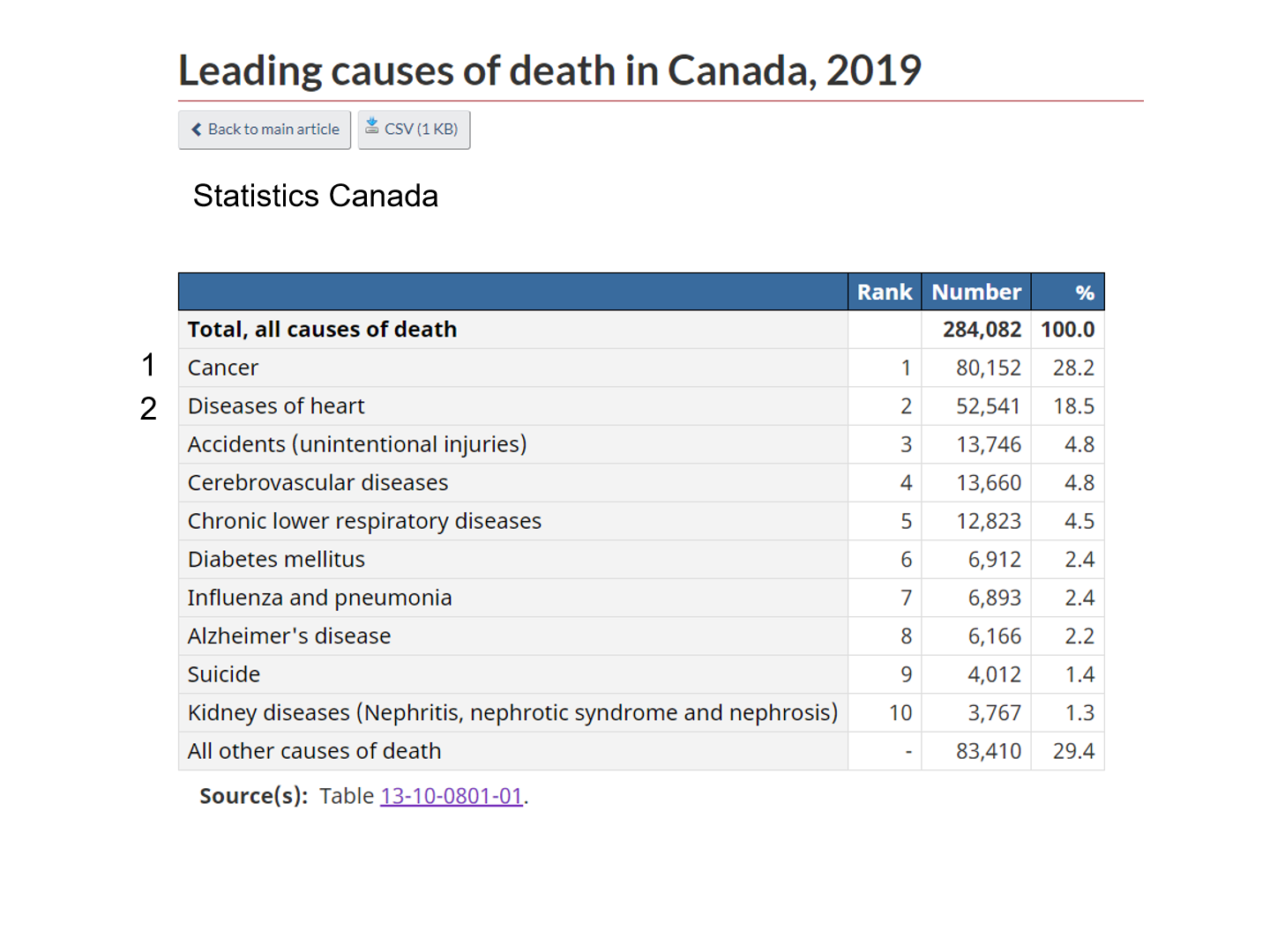
1. Cancer
2. Heart disease
3. Accidents
BMI (body mass index)

BMI = kg/(m)2
- <18.5 = at risk
- 18.5-24.9 = healthy
- 25-29.9 = overweight
- >30 = obesity
Obesity prevalence in Canadian adults
36.3% have overweight + 26.8% have obesity = 63.1% unhealthy weight
* greatest recent increase in obesity is in 20 to 39 yr olds
Obesity prevalence in Canadian children
17% have overweight + 9% have obesity = 26% unhealthy weight
Is obesity simply linked to calories?
NO! Obesity is a complex, multifactorial chronic disease. Calorie intake is just one contributor.
Are Ancient diets best?
• Some claim the healthiest diet is one that was eaten during the Paleolithic era 10,000 years ago.
• The Paleo diet restricts what you eat to foods the hunter-gathers of the Stone Age ate.
• They would overeat when food was available to protect them during famine.
• Very common to cycle through periods of feasting or famine
– “Feast or famine”
Feast and Famine then vs. now
Then: root vegetables (high in fibre), nuts, seeds, wild game
Now: too much choice contributes to overeating
What are some biological processes in the body that make it difficult to stay healthy in the current food environment?
• We get hungry every 4-6 hours even in the presence of excess body fat stores
– Today this can lead to consuming more calories than we burn
• Our bodies conserve sodium
– historically, diets were low in sodium and there was lots of vigorous activity, sweating, and diarrhea
– so it was advantageous to conserve sodium for survival.
– Today, this conservation of sodium in the context of a high sodium (salt) diet, leads to high blood pressure
Why do we naturally prefer fatty and sweet-tasting foods?
– sweet taste: we evolved to associate sweet taste with calories and nutrients that are safe for human consumption; help orient our behavior to seek out and consume these foods
– bitter: associated with toxic products (a lot of good vegetables taste bitter therefore people consume fewer)
– Today, we overconsume sugary foods and eat fewer vegetables
Were they healthier in the stone age?
– Many died of starvation
– Vitamin deficiencies & food poisoning
– Died younger so less degenerative disease
Should we eat like them?
Not necessarily...
– Meat differs (leaner back then)
– Fruits & vegetables differ (different types, nutrient levels may vary)
– Environment is different (more pollution, sedentary behaviour, etc.)
*Therefore, strive for more exercise & wholesome foods
What are some typical problems with sources of nutrition information?
– Tight deadlines
– Limited understanding
– Single study
– Report scientific findings prematurely
Half-truths and hype are common in books, newspapers, magazines, TV, radio, pamphlets, internet, speeches, etc.
– But we have the right to free speech...
Nutrition in media
• It is unlawful to state false claims on a product label or in an advertisement
• It is unlawful to use the U.S. or Canadian mail systems to send fraudulent products or receive payments for fraudulent products
*But rarely are these laws enforced, and penalties are minimal
What is the primary reason for nutrition misinformation?

Profit
• As long as people think there is a quick and easy way to lose weight, build muscle, slow aging and reduce stress, there will be a huge $$$ market for “nutritional” products and services
• The world market for vitamins alone is over $3 Billion!
Registered dietitian degree breakdown
* B.Sc. in nutrition
* Internship
* National licensing exam
* Registration (College of Dietitians of Alberta)
* RD
Nutritionist title
• Before September 2016 the title ‘Nutritionist’ could be used by anyone in Alberta to describe themselves as a professional in the Nutrition industry.
• As of September 2016, the title ‘Nutritionist’ can only be used by members of the College of Dietitians of Alberta.
– Registered Dietitian
- Registered Nutritionist
– RD
- Dietitian
– Nutritionist *
What are some sources of reliable nutrition information
• Health organizations (eg. Heart and Stroke Foundation; Canadian Diabetes Association)
• Scientific organizations (eg. Canadian Nutrition Society)
• Professional organizations (eg. Dietitians of Canada)
• Government publications (eg. Health Canada)
• Registered, licensed or certified dietitians
• Nutrition textbooks (not diet best sellers)
What is the importance of nutrition research?
• Facts and evidence provided by scientific studies: used to develop nutrition information and guidelines that affect public’s health.
• Peer-reviewed papers published in scientific journals.
Ways to identify nutrition quackery
1. Too good to be true or a quick fix
2. Testimonials (before and after pictures)
3. Make you suspicious of food supply
4. Fake credentials
5. Elimination of whole food groups
6. Use of the word ‘natural’
7. Supplements needed by all; megadoses
Gut-brain connection

Implies that there is a connection between gut microbiota and stress/mood.
*Probiotics may improve psychological symptoms associated particularly with anxiety
What foods must be labeled?
• Foods containing more than one ingredient (mostly processed foods)
• Dietary supplements
• If a claim is made - “low fat,” “low calorie,” etc. - must display nutrition information backing the claim
What dietary claims have guidelines vs which don't?
– Light: no guidelines
– Low sugar: no guidelines
– Reduced fat or calories: 25% less than the original
– Fat free: <0.5g
Foods that are not required to be labeled
• fresh fruits and vegetables
• raw, single-ingredient meat, poultry, fish and seafood
• very small packages, such as one-bite candy
• items with insignificant calories and nutrients, such as herbs and spices
• food sold at farmer's markets
• food sold only in grocery stores where the product is prepared or packaged in-store (e.g. bakery, salads)
• alcoholic beverages
Organic foods
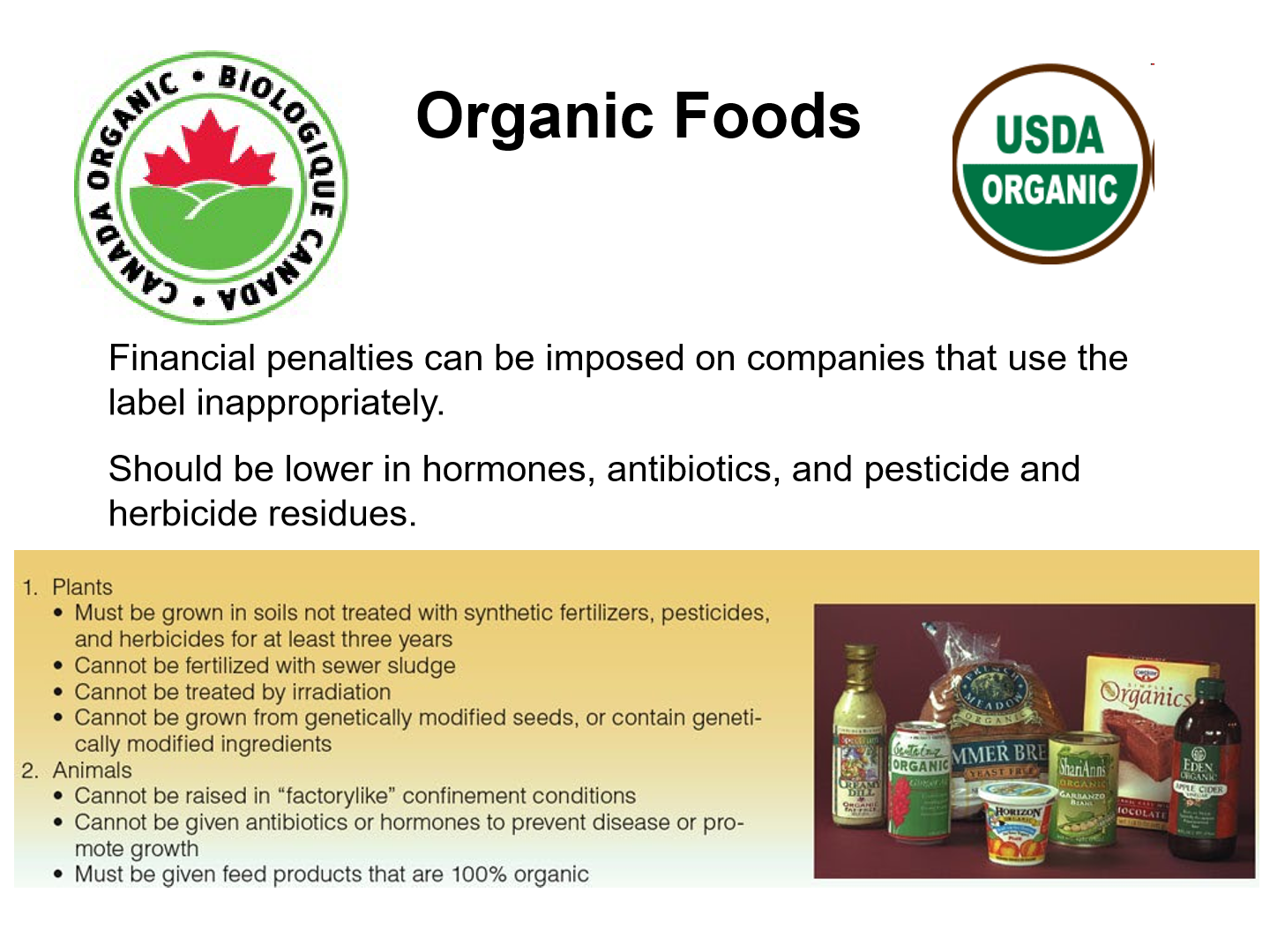
Should be lower in hormones, antibiotics, and pesticide and herbicide residues.
Animals and Plants organic outlines
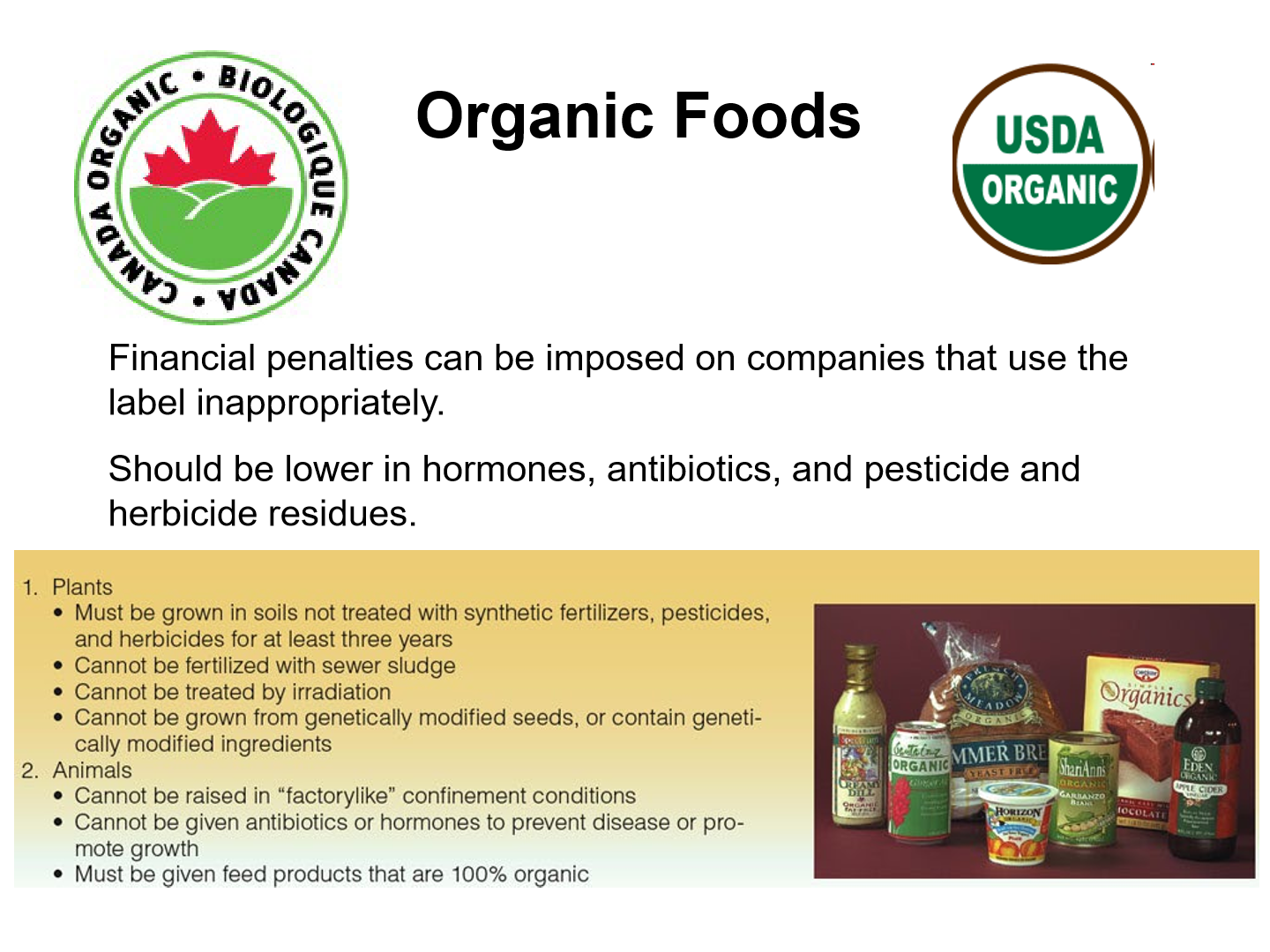
Regulated by the Canadian Food Inspection Agency
1. Only products with organic content of ____ can be labelled as organic.
A. >50%
B. >70%
C. ≥95%
C
2. ‘Organically grown’, ‘organically raised’ or ‘organically produced’ all mean the same as organic and meet the same requirements.
A. True
B. False
A
If a multi-ingredient product has 70 to <95% organic content:
• Must declare the percentage of organic content on the label
• May NOT use the organic logo nor the claim organic
• If <70% organic content, can only indicate which ingredients are organic in the ingredient list
Is organic food healthier than non-organic?
Nutrient-wise (protein/vitamins/etc.) they are similar. One difference is that organic fruits & vegetables can have higher antioxidant content. Organic diets do lead to less pesticide exposure.
What food is a better investment buying organic?
• Avocados, cantaloupe, pineapple, broccoli, cabbage and corn have low levels of pesticides, so less advantage to buying organic.
• Strawberries, spinach, grapes, apples, tomatoes and celery have higher levels of pesticide residues.
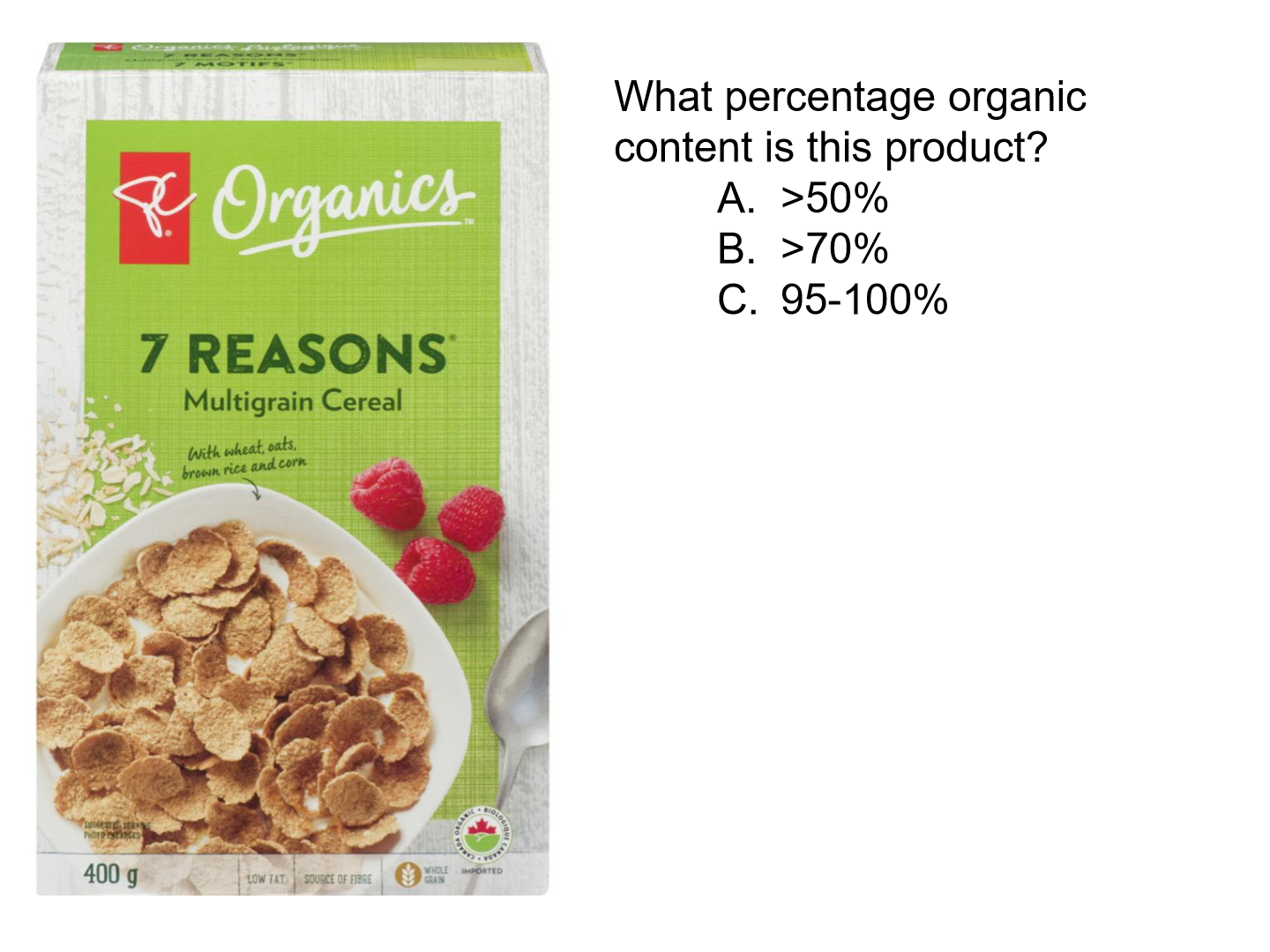
C
- it has the Canadian organic logo
Health claims on food
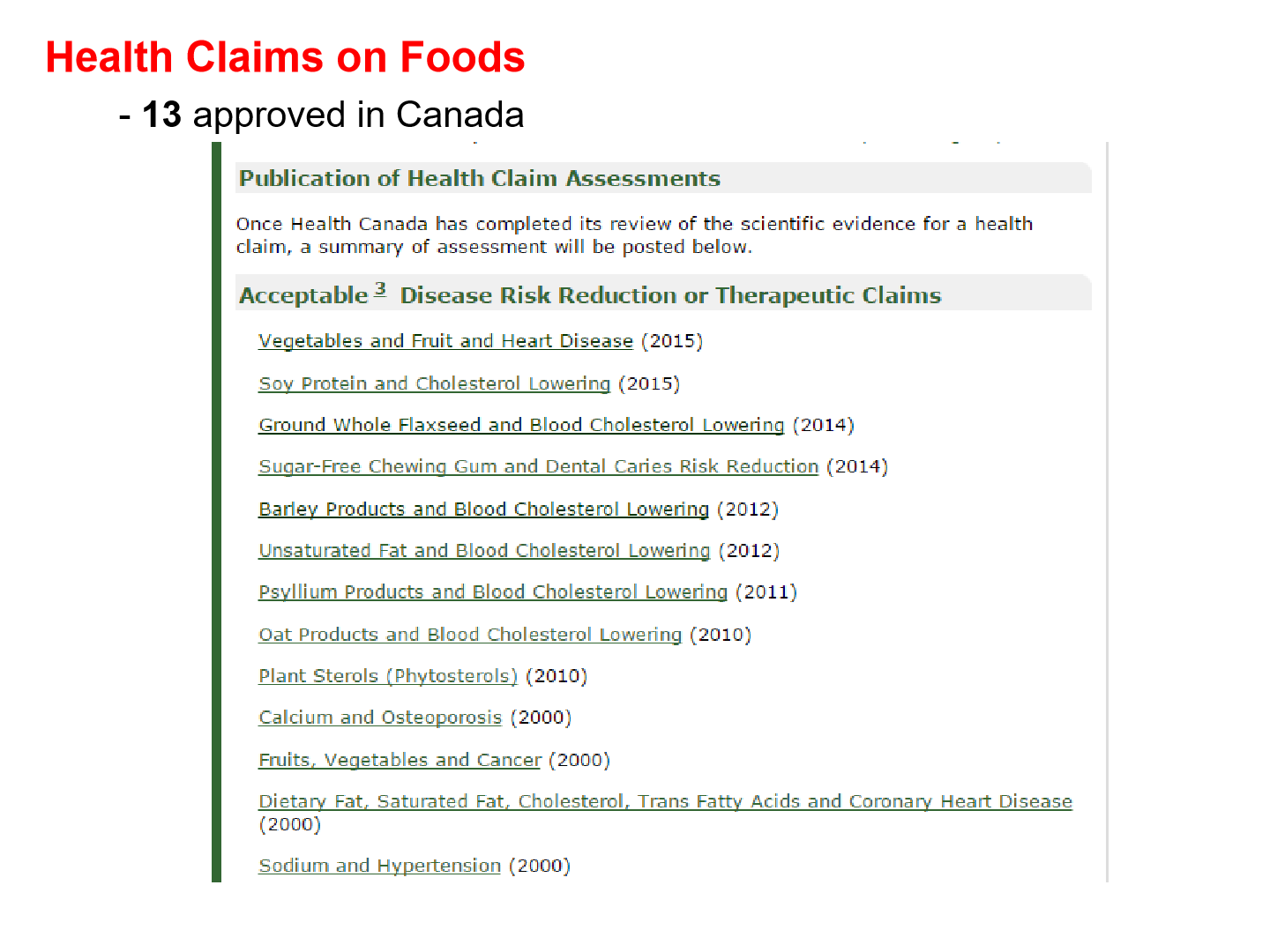
There are 13 approved in Canada
Enrichment
pertains only to refined grain products where thiamin, riboflavin, niacin, and iron lost in milling are added
– Producers of bread, cornmeal, pasta and crackers from refined grains must use enriched flours
Fortification
the addition of a vitamin or mineral not normally found in the food
Rules of the ingredient label (2)
• All ingredients must be listed in descending order of amount present (by weight)
• Ingredients causing allergic reactions (peanuts, tree nuts, milk, eggs, fish, shellfish, wheat, soy, sesame and sulphites) must also be listed on the ingredient label
Do food additives need to be on the label?
YES!
• Food additives must be listed
• 3000 chemicals are added to food to enhance its flavor, color, texture, cooking properties, shelf life, or nutrient content
• Food additives with “GRAS” can be used without pre-approval (Generally Recognized As Safe)– Sodium chloride, sucrose, cornstarch, many vitamins/minerals
• New additives must be approved by Health Canada prior to use
Irradiated foods
1. Must contain radura symbol
2. Uses:
- Prevent sprouting
- Delay ripening
- Kill insects/mold/bacteria
- Potatoes, onions, wheat, flour, spices, ground beef
3. Foods do not retain radioactive particles
4. Doses: 10-20X higher than lethal dose in humans
Dietary supplement labeling
• Dietary supplements must be labeled
• Dietary supplement labels cannot claim the products treat, cure, or prevent disease
• Not classified as a drug, so no vigorous testing
*must have a product license
Do we have an innate nutrient drive?
NO!
• We don’t generally seek out nutrients we are deficient in
• Select food based on food preferences, culture, nutrition knowledge & beliefs, cost, hunger, availability, convenience
• Humans and most animals will seek water and food, but not generally the best foods, unless they have learned how to eat a well-balanced die
How Do We Decide When and How Much to Eat?
• Hunger, satiety and thirst centers are located in the “primitive” brain
– Hypothalamus – appetite centre
• Inborn attraction to sweet and salty tasting foods, dislike of bitter and sour foods
Do infants also prefer sweet food?
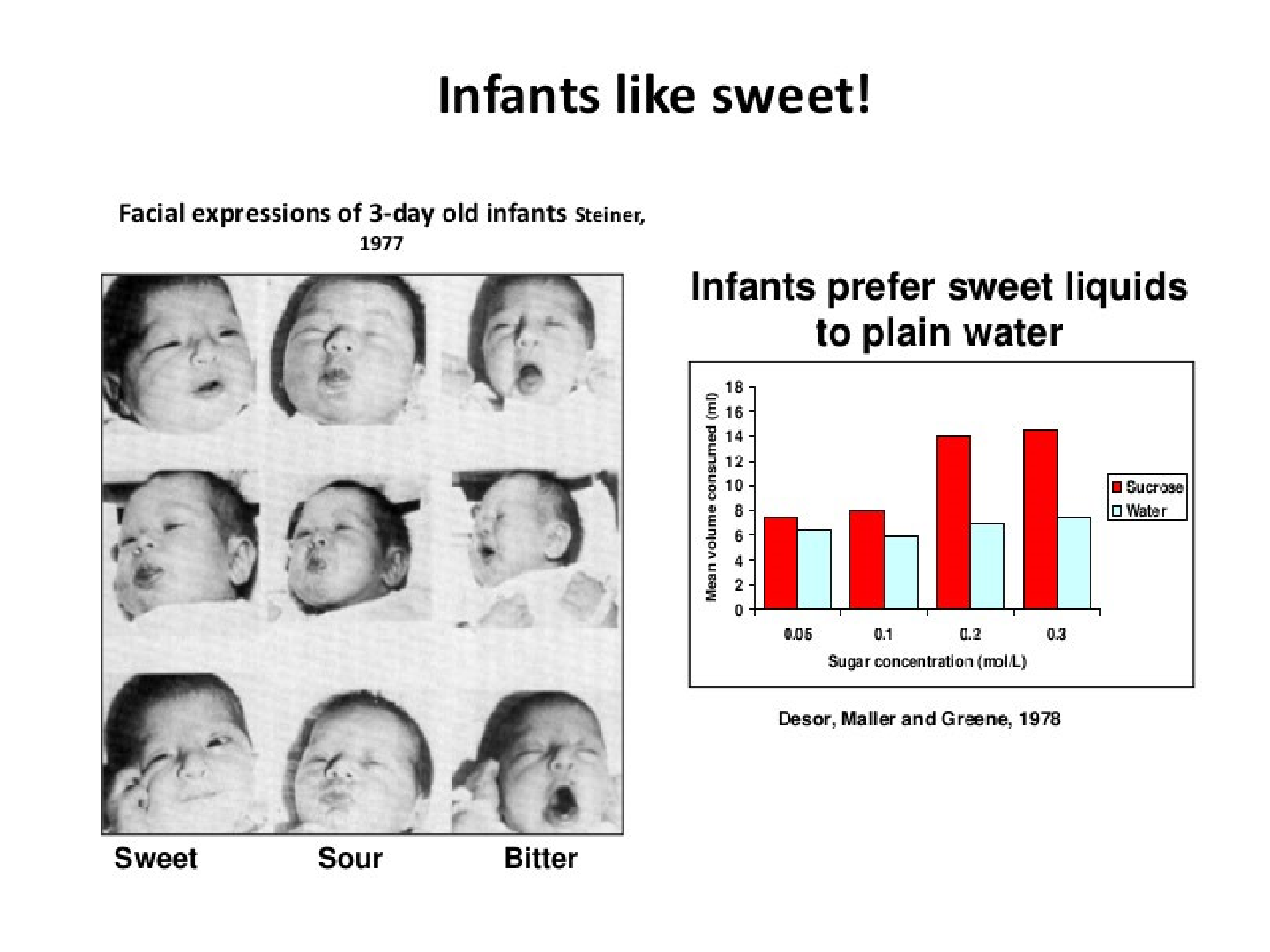
YES!
What Makes Us “Like” or “Dislike?”
• The strongest influence is “food preference,” a learned behavior
• Food preference is shaped by memory and memories are based on culture and the pleasure associated with the memory
• We reject foods that bring us discomfort, guilt and unpleasant memories (e.g. eating something that gave us food poisoning; as a child having to eat vegetables before leaving the table)
How does food marketing influence what we eat?
• Food marketing can influence food choices. It is designed to:
– create food trends
– encourage you to:
• buy certain foods or drinks
• buy foods in order to get promotional items such as:
– loyalty points
– tickets to movies or sports events
– coupons for future food purchases
– create links between certain foods or brands and a particular lifestyle
– build brand loyalty so you will continue to purchase from a particular store or products with a brand name
Red and food
enhances appetite; increases heart rate
Green
healthy; eco-friendly; natural
White
reduced calories
Yellow
happiness & youthfulness; brain processes yellow very rapidly
Orange
good value; stimulates appetite and conversation
Brown
rich flavour
Blue
suppress appetite; most unappetizing color (only really in children food)
What makes an adequate diet?
• Variety of foods provide sufficient levels of calories and essential nutrients
• An adequate diet contains all nutrients necessary for long-term survival but it may not necessarily be optimal or have any variety.
What makes a balanced diet?
• Provide calories, nutrients, and other components in the right proportions
• A balanced diet has the six classes of nutrients in good proportion
Essential nutrients
Nutrients the body cannot produce, or produce in sufficient amounts; must be obtained in the diet– Example: Iron, calcium
Nonessential nutrients
Nutrients the body can manufacture in sufficient quantities– Example: Cholesterol
Recommended nutrient intake of carbohydrates, fat, protein and fiber
Carbohydrates: 45-65%
Fat: 20-35%
Protein: 10-35%
Fiber: 25g-38g
Why is the western diet bad?
• Western diet overloaded with
– Refined sugars
– Saturated fats
– Salt
• Low in
– Essential fatty acids
– Dairy products
– Vegetables and fruits
– Fiber
• High intakes of fat (saturated fat and trans fat) are risks for heart disease and metabolic syndrome
• Low intake of dairy products and vitamin D are risks for osteoporosis
Western diet with vegetables and whole grains
• Only 6% of adults regularly consume broccoli, cauliflower, Brussels sprouts, or dark, leafy green vegetables– These are associated with reduced cancer risk– Most commonly consumed vegetable in the U.S. is the potato
• More whole grains are needed– Whole grains reduce the risk of certain types of cancer, type 2 diabetes and heart disease
• Americans consume an average of one serving of whole-grain products daily
What are some different guides to healthy diets?
• Canada’s Food Guide (HC)
• MyPlate (USDA)
• Mediterranean Food Pyramid (WHO)
What were the 4 food groups in the previous food guide?
1. Grain products
2. Vegetables and fruit
3. Milk products
4. Meat and alternatives
Does the new food guide use food groups?
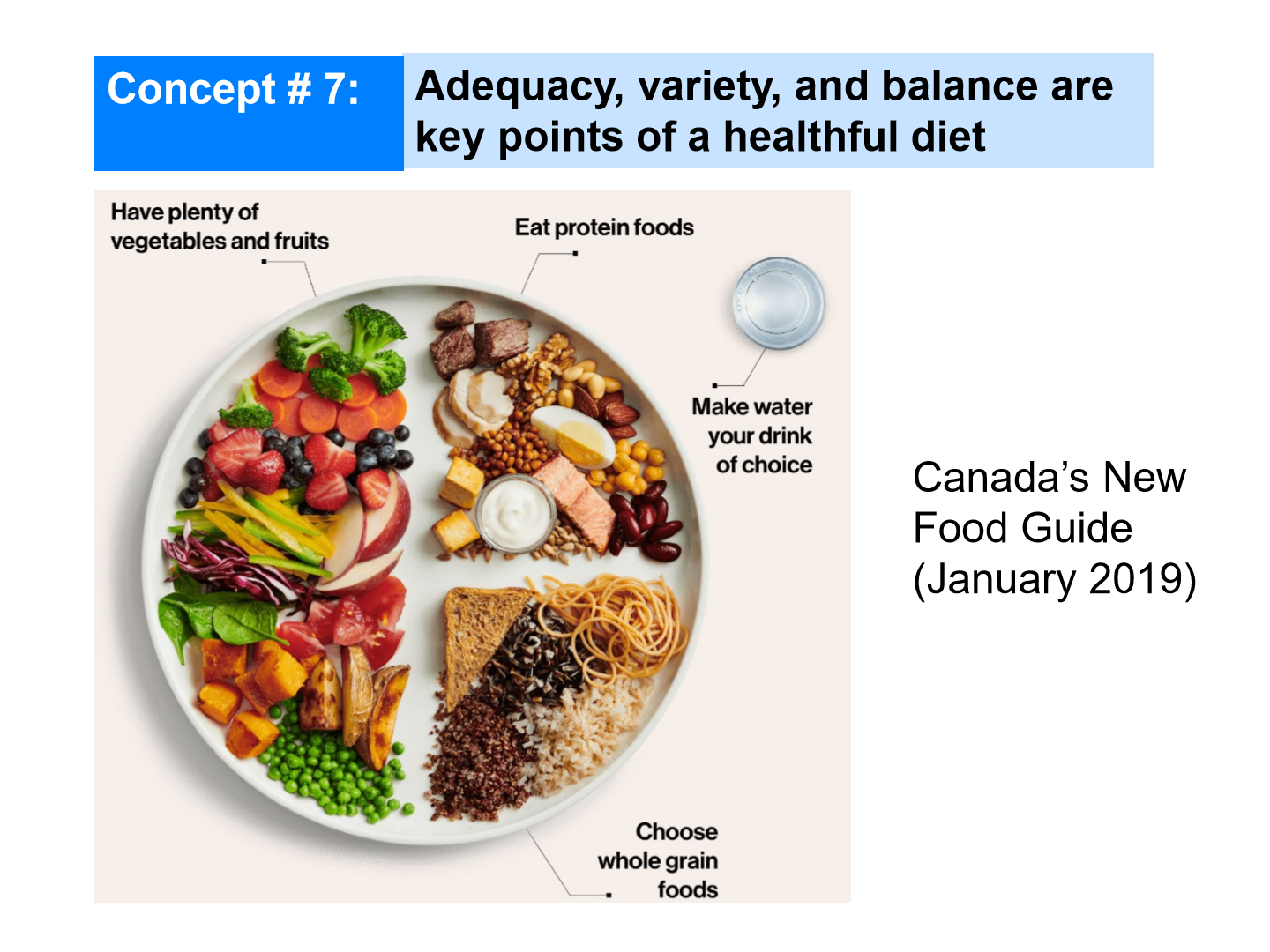
Not really
- The new Food Guide focuses on broader statements and no longer uses the food group categories.
USDA MyPlate guides
Grains: Make half your grains whole grains.
Protein: Vary your proteins.
Vegetables: Make half your plate fruits and vegetables; vary your vegetables.
Fruits: Make half your plate fruits and vegetables; focus on whole fruits.
Dairy: Move to low-fat or fat-free dairy milk or yogurt.
Mediterranean Diet Pyramid
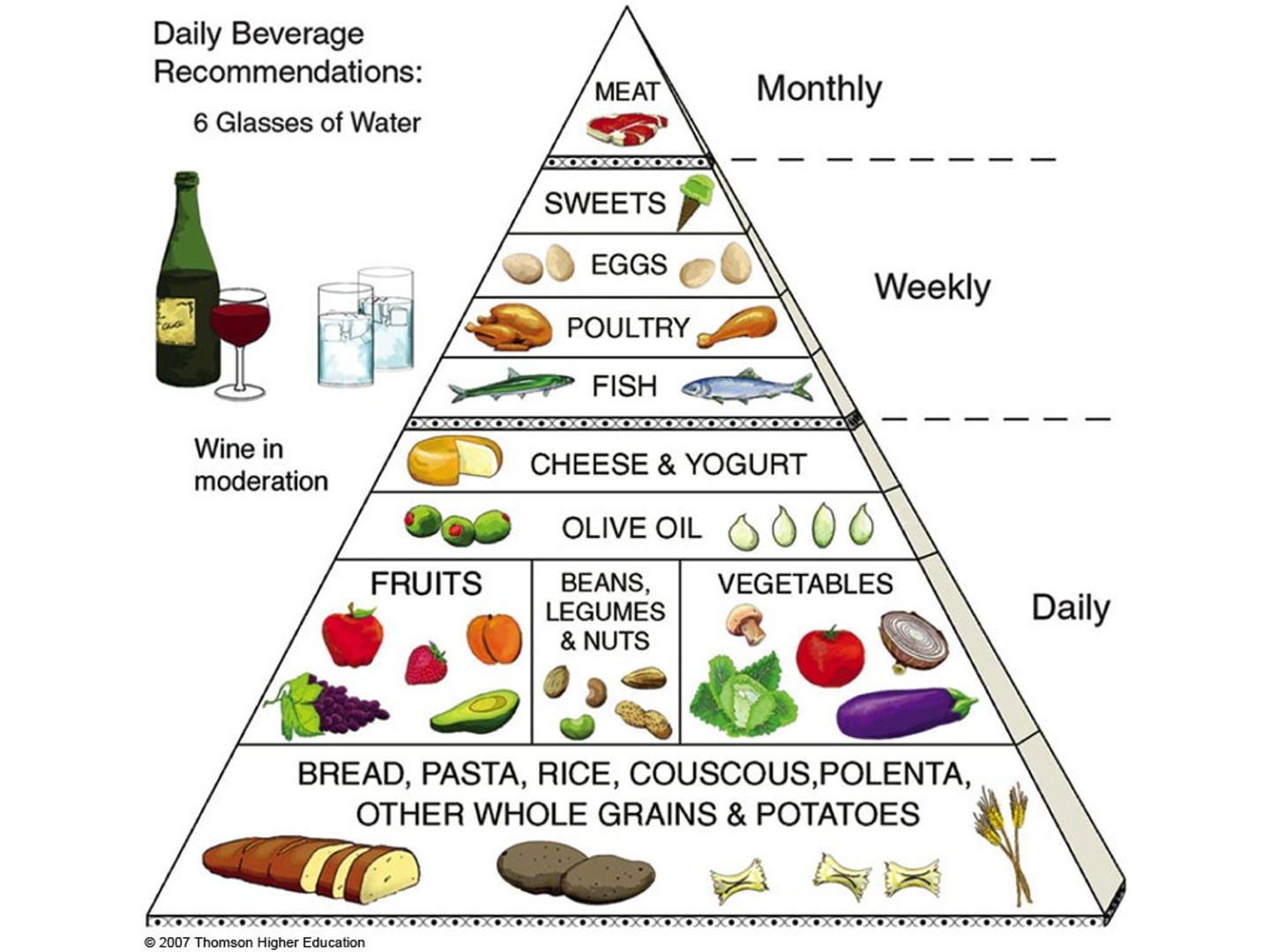
• WHO developed guide in 1994 to help popularize a diet associated with reduced risk of heart disease and cancer
• Emphasizes olive oil, breads, whole-grain cereals, nuts, fish, dried beans, vegetables, and fruits; and wine in moderation
• Intake of red meats is limited to monthly, and sweets and poultry to weekly intake
• Key features: rich in plant foods, olive oil, limited red meat
The gut and nutrition
The Gut
• Approximately 92 - 99% of the protein, fat and carbohydrate that we consume is digested and absorbed
• Most of the dietary fiber is not digested
– Most is fermented by bacteria
Mechanical digestion
• Physical breakdown of food
• Chewing, grinding and mixing food with mouth, tongue and teeth
Chemical digestion
• Chemical breakdown of food using enzymes, bile and hydrochloric acid
• There are over 100 enzymes that are secreted by the digestive system
The digestive system is made up of the following:
- Mouth- Pharynx- Epiglottis- Esophagus- Stomach- Small intestine- Large intestine- Rectum- Anus
Accessory organs to the digestive system
- Liver- Gall bladder- Pancreas
Heartburn
• Caused by excessive stomach acid or defective lower esophageal sphincter
– causes burning sensation in the esophagus.
• Acid reflux is a common medical condition that can range in severity from mild to serious. Gastroesophageal reflux disease (GERD) is the chronic, more severe form of acid reflux. Heartburn is a symptom of acid reflux and GERD.
• Stress, anxiety, frequent use of aspirin and other anti-inflammatory medicines, fatty foods, spicy foods, coffee, alcohol, citrus fruits, soft drinks, and other foods are involved
• Weight gain and eating within 3 hours prior to going to bed increase symptoms
– weight gain of 10-20 pounds associated with a 3-fold increase in heartburn symptoms
How to help heartburn
• High-fiber diets protect against development of heartburn
• Treatments include
– stress reduction
– elimination of offending foods
– eating small, frequent meals
– mild occasional heartburn can use over-the-counter antacids but with persistent symptoms, prescription medication may be needed (e.g. H2 blockers, proton pump inhibitor)
Ulcers
• Develop when protective stomach or duodenum lining is damaged
• HCl lowers the pH of the stomach to about 1.5 – 2
• Stomach acid and digestive enzymes erode the lining(s) and cause an “ulcer”• Duodenal ulcers are 10x more common than stomach ulcers and are closely associated with Helicobacter pylori (H. pylori) bacteria'
• Rates of H. pylori infection are highest in countries with poor sanitary conditions.
• Classified as Class I carcinogen – stomach cancer
Known human carcinogens:
– Alcoholic beverage consumption– Asbestos– Cadmium– Engine exhaust, diesel– Epstein-Barr virus (infection with)– Human papilloma virus (HPV)– Ionizing radiation– Workplace exposure as a painter– Tobacco smoke, secondhand, smokeless– Radon
Stomach to Small Intestine
• Stomach percolates chyme into the small intestine
– Solid foods stay in stomach for about 2-4 hours, liquids pass through in about 20 minutes
– Solid food is passed to the small intestine about 1 to 2 teaspoons at a time
• The small intestine is about 6 meters long and composed of 3 segments: duodenum, jejunum, and ileum
• Available surface area of small intestine is about the size of a baseball infield, 675 square feet
• Intestinal cells turn over every 4-5 days– High nutrients needs
The Exocrine Pancreas
The enzymes produced by the pancreas act to breakdown all of the major energy nutrients:
• Carbohydrates (Amylases)
• Proteins (Proteases)
• Fat (Lipases)Absorption also begins to take place. Small molecules are transported into cells lining the small intestine
Absorption
The end products of digestion are taken up by:
• Blood vessels (carbohydrate and protein breakdown products) for distribution to the body
• Lymphatic vessels (fatty acids from fat breakdown)
– Empty into the subclavian veins that feed back to the heart
Functions of the liver
• Detoxification (amino acid catabolism yields ammonia – neurotoxin - liver converts ammonia to urea)
• Protein synthesis (clotting factors, IGF-1)
• Metabolic control (glucose, lipids)
• Glycogen formation and storage
• Triglyceride and cholesterol production
• Produces bile (stores in gallbladder)
• Red blood cell degradation
• Hormone production
• Amino acid synthesis
• Stores vitamin A, D, B12, iron & copper
• Synthesizes angiotensinogen
The Large Intestine
• Water, sodium, and some of the end products of bacterial digestion are absorbed from the large intestine
• Bacteria digest fiber and complex carbohydrates that we can’t digest
• These bacteria excrete gas and short chain fatty acids that can be absorbed in large intestine
• Substances that cannot be absorbed are excreted as feces
Constipation and Hemorrhoids
• Constipation and hemorrhoids are due to diets with too little fiber
• Adults need fiber intakes of 25 g/day (females) to 38 (males) g/day plus plenty of fluids
• This regimen will help prevent constipation and hemorrhoids in healthy people
Diarrhea
• Severe diarrhea leads to dehydration, heart and kidney malfunction, and death
• Most due to bacterial- or viral-contaminated food or water, lack of immunizations against infectious diseases, and deficiencies of various nutrients
• 3.5 million deaths from diarrhea occur annually to children five years old or less
Can microbiota transfer disease?
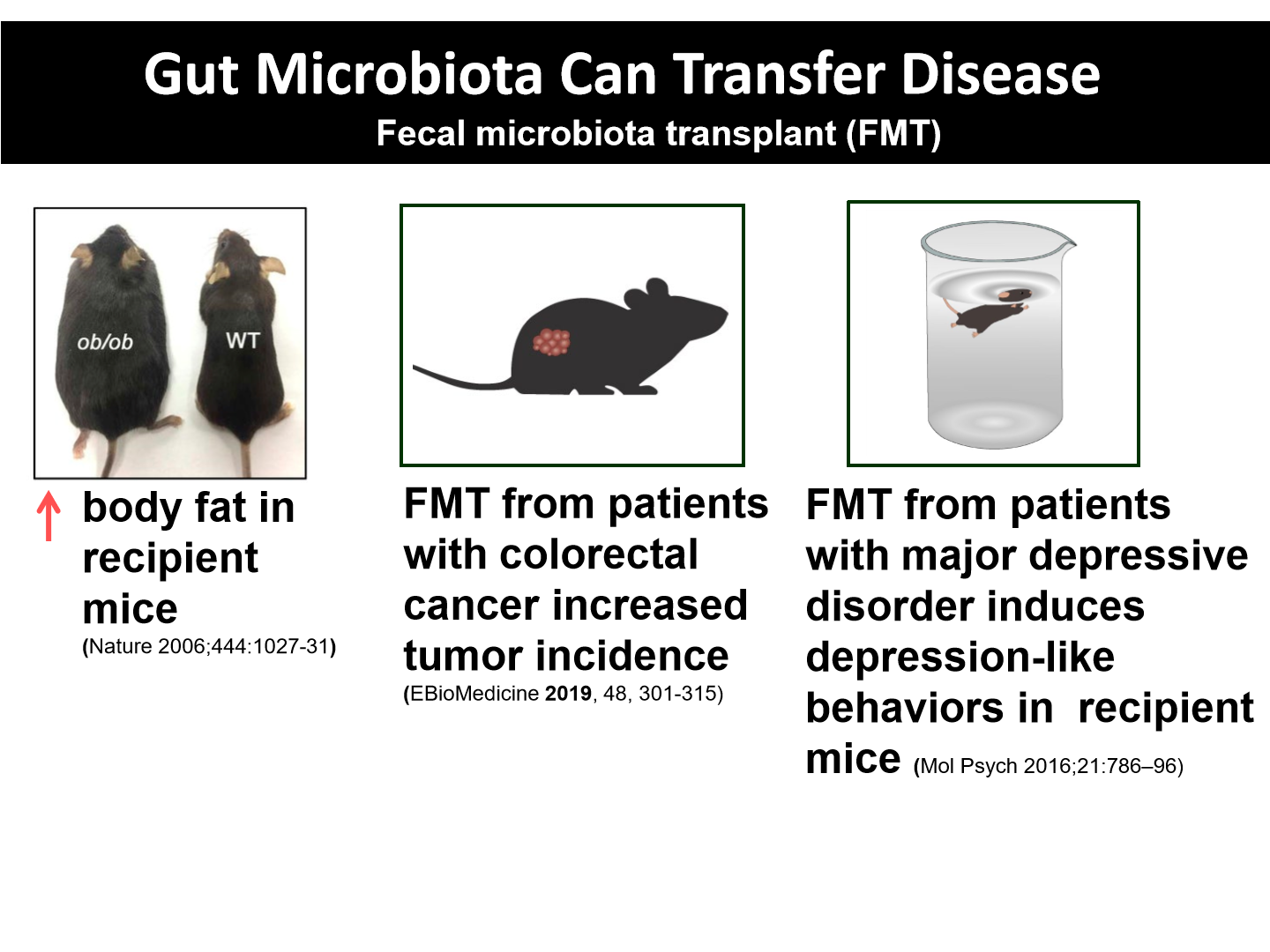
YES
Bacteria: Friend or Foe?
- Late 1800’s discovered bacteria can cause infections.
- 1928 penicillin was discovered.
- Before antibiotics, 90% of children with bacterial meningitis died.
- increase antibiotic use coincided with increase childhood asthma & obesity
What is the most densely colonized ecosystem of the human body?
The gut!
- viruses, bacteria, fungi, protozoa
Human Gut Microbiota in Health
• Break down dietary fiber
• Produce certain vitamins (vitamin K, B vitamins)
• Trains the immune system
• Suppress growth of pathogenic bacteria
• Motility and intestinal function
• Drug metabolism (>50)
• Affect mood
What is it called when microbiota becomes imbalanced?
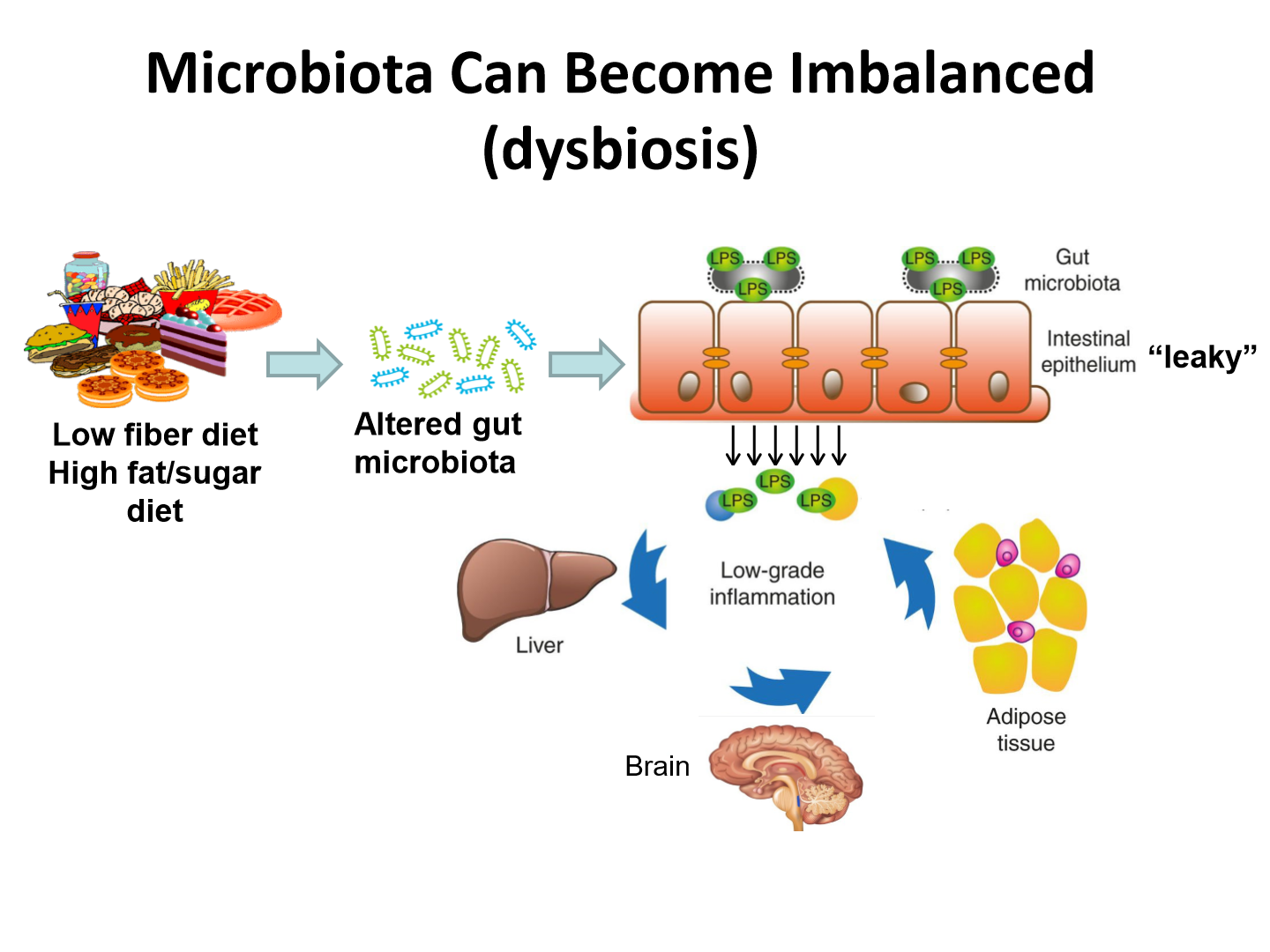
dysbiosis
What promotes a good gut microbiome/symbiosis?
- high fiber
- whole natural foods
What can cause dysbiosis?
- high fat, high sugar
- dietary emulsifiers (polysorbate 80 & carboxymethylcellulose)
- artificial sweeteners
- ultra-processed foods
What is a dietary Calorie?
one kilocalorie (kcal)
- the amount of heat required to raise the temperature of 1kg of water 1ºC
How many calories per gram does different macromolecules have?
• Carbohydrates and Protein– ~4 kcal/gram
• Alcohol– ~7 kcal/gram
• Fat– ~9 kcal/gram
How do we calculate % calories?
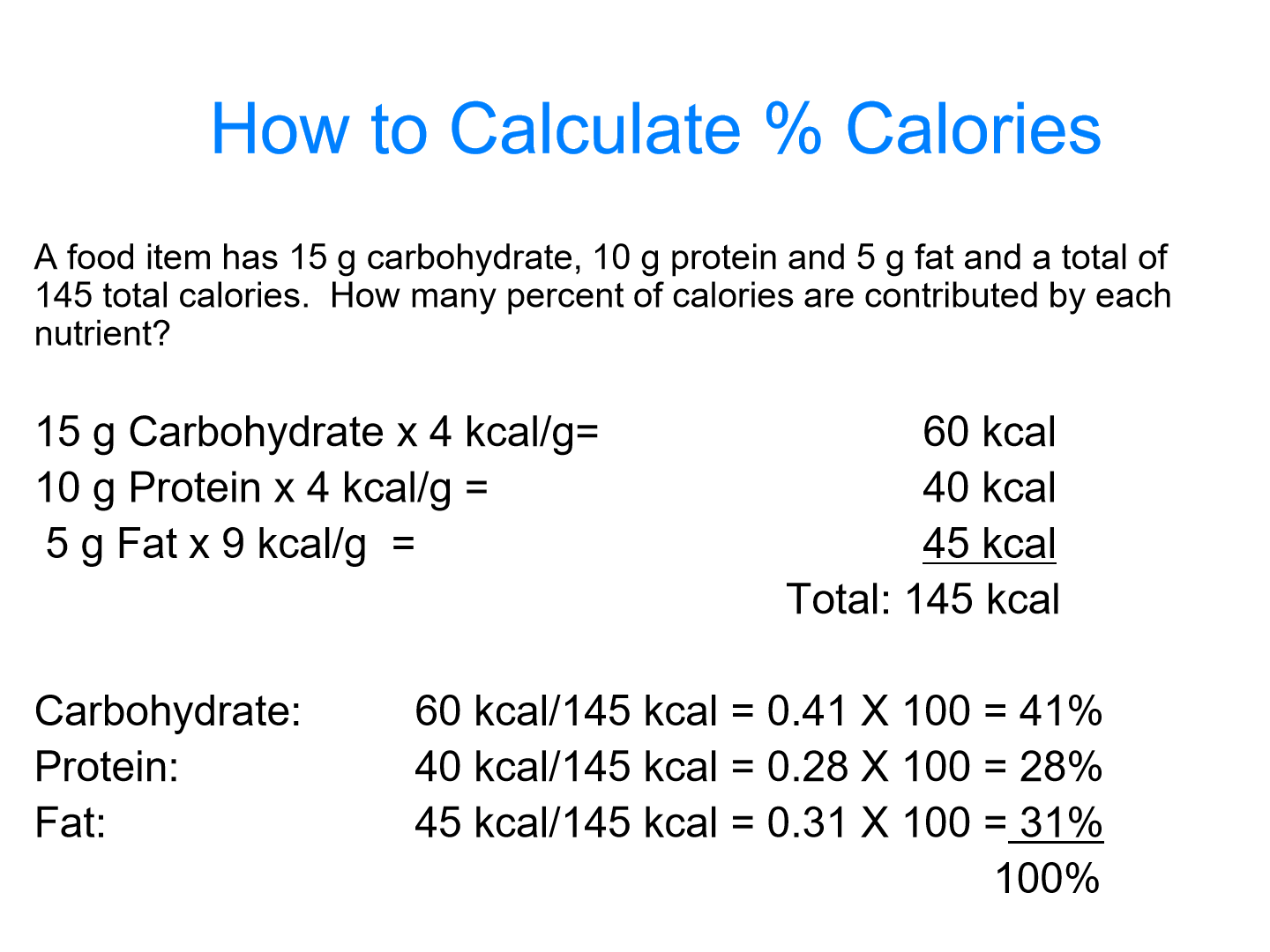
How do these different factors affect basal metabolic rate?
1. Age2. Height3. Growth4. Body composition5. Fever6. Stress7. Environmental temperature8. Fasting/starvation9. Malnutrition10. Thyroxine
1. Age (older = BMR decrease)
2. Height (increase as you get taller)
3. Growth (increases during periods of growth)
4. Body composition (increases with mass)
5. Fever (increase BMR)6. Stress (increases BMR)
7. Environmental temperature (extreme temperatures increase BMR)
8. Fasting/starvation (decrease BMR)
9. Malnutrition (decrease BMR)
10. Thyroxine (hyperthyroidism=increase, hypothyroidism=decrease)
Approximate Basal Caloric Need calculation
Men = Body weight (lbs) x 11 kcal/lb
Women = Body weight (lbs) x 10 kcal/lb
(e.g. 130 lbs x 10 kcal = 1300 kcal per day)
What is the more precise BM calculation?
the harris-benedict equation (weight, height and age)
How do you add physical activity to BMR calculations?
1. Activity tables (sum all activity for the day)
2. Activity factors (simply multiply by a factor)
- Inactive = basal metabolism x 1.3- Average = basal metabolism x 1.5- Active = basal metabolism x 1.75
kcal/min ______ with _______ body weight - converse is true
increases; increasing
e.g. cycling 15 mph [110 lb. = 5.4; 200 lb. = 9.8]
Estimating total calorie need
Basal metabolism: 130 lb. x 10 = 1300 kcal
Add physical activity: 1300 x 1.3 = 1690 kcal
Basal + PA: 1690 kcal
Dietary thermogenesis: 1690 x 0.10 (for 10%) = 169
Total: 1859 kcal
Hunger
Physiological Influences for Hunger
• Empty stomach
• Gastric contractions
• Absence of nutrients
• GI hormones (elevated ghrelin)
• Endorphins (brain’s pleasure compounds)
Satiation
Why we stop eating
• Presence of food triggers stretch receptors
• Nutrients in intestine elicit satiety hormones
• GLP-1
• CCK
Satiety
Why we do not start eating
• Nutrients in blood signal brain
• As nutrients diminish, satiety diminishes and hunger develops
• Hunger hormones increase
• Ghrelin
What is the percent essential fat?
men: 3%
women: 12%
*vital for metabolic processes
(bone marrow, CNS, internal organs)
What is the acceptable % body fat?
men 18-25% (≥26% classified as obesity)
women 25-31% (≥32% classified as obesity)
What is the fitness % body fat?
men 14-17%
women 21-24%
Once we get bellow a certain threshold what may occur?
infertility, develop depression, abnormal hunger regulation, unable to keep warm
Where is it best to store fat? What is an at risk waist size
Excess fat in the chest and stomach areas (apple-shaped; visceral/central/abdominal fat) = higher risk for diabetes, heart disease, and hypertension
than excess fat in thehips, thighs, and buttocks (pear- shaped; subcutaneous fat).
At risk when waist is:women > 88 cm (women)man > 102 cm (men)
Metabolic syndrome
Presence of 3 of the following:
• Abdominal obesity
– Waist circumference greater than 102 cm (40 inches) for men,
– Greater than 88 cm (35 inches) for women.
• Elevated levels of triglycerides (1.7 mmol/L).
• Low levels of HDL (<1.0 mmol/L for men & 1.2 mmol/L for women)
• High blood pressure/hypertension (> 130/85)
• Impaired fasting glucose (> 6.1 mmol/L)
4 different ways to measure body composition
1. Fat-fold measure
2. Underwater weighing
3. Bioelectrical impedance
4. DXA
Fat-fold measure
use caliper to gauge thickness of a fold of skin on back of arm (tricep), below shoulder blade (subscapular), chest, abdomen, thigh
Underwater weighing
measure body density by weighing person first on land and then submerged in water. Uses the amount of water displaced and the known density of fat mass and lean mass. By volume, fat weighs less than muscle, and kg for kg, fat, and muscle each have a constant mass and displace a specific amount of water.
Bioelectrical impedance
use low-intensity electrical current. Lean tissues conduct more current, fat more resistant to current.
*muscle conducts more current
DXA
use low-dose x-ray absorption to measure lean and fat mass and bone density
*most accurate
What is a limitation of BMI
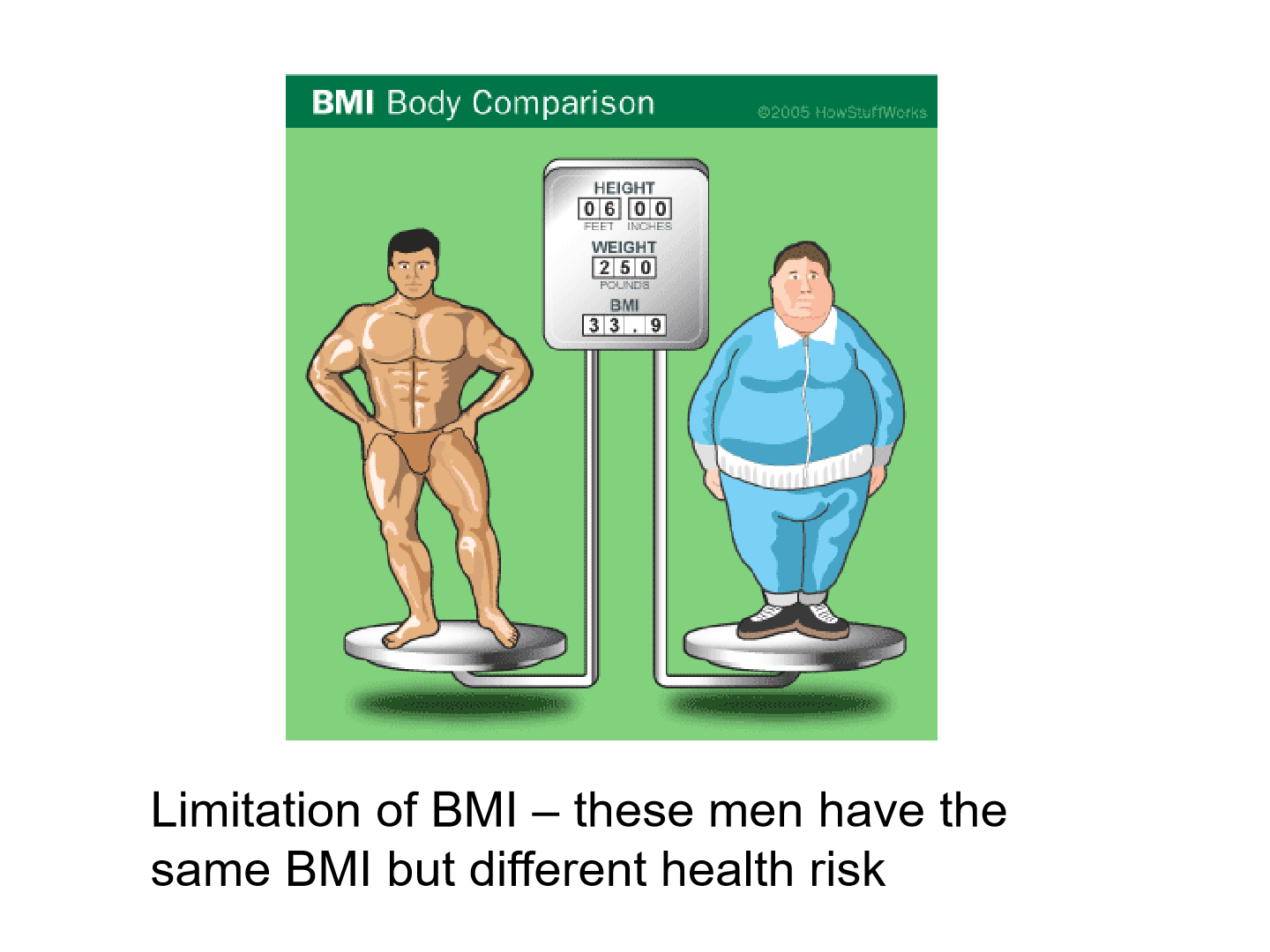
muscle vs. fat
Fad diets
very different from healthy eating
- non-lasting, trendy diets
Weight loss by dieting
Greatest weight loss is during the 1st week of dieting...
– It is a loss of CHO and H2O (70% H 2 O, 25% fat, 5% lean mass)
– We lose primarily glycogen: 1 gram glycogen: 3 g H 2 O
– Rapid weight regain when you resume normal eating after 1 wk
**Begining loss is water weight
2nd and 3rd weeks of dieting
• In 2nd week of dieting...– 20% H 2 O– Fat and Lean mass
• In 3rd week of dieting...– Minimal H 2 O loss– Fat and Lean mass
How do we preserve lean mass?
Resistance exercises and protein
What happens as we continue to diet?
Weight loss becomes increasingly difficult because you need fewer kcal to maintain new lower body weight (basal energy needs are tied to body weight – and they go down as body weight goes down)
What are the 2 ways of fat cell development
1. Hyperplasia
2. Hypertrophy
Hyperplasia
single cell can give rise to new cells
Hypertrophy
cells get bigger
When do we primarily see fat cell development?
Occurs at critical periods in life: adipose cell # increases at late childhood; puberty; when cells reach maximum
LPL (lipoprotein lipase)
promotes fat storage in adipose and muscle
*people with high LPL store fat very efficiently
LPL and obesity
individuals with obesity have more LPL activity per fat cell and more fat cells
- even modest excess in energy intake has more dramatic effect in an individual with obesity versus lean
*makes weight loss difficult
LPL and gender
gender-specific hormones: in women fat cells in breasts, hips & thighs produce more LPL and in men cells in abdomen produce more LPL
LPL after weight loss
after weight loss - LPL increases – explains why you lose weight and regain so easily -- set point; the increase is more dramatic in individuals with obesity* takes at least a year to 'reset'
An increase in Leptin
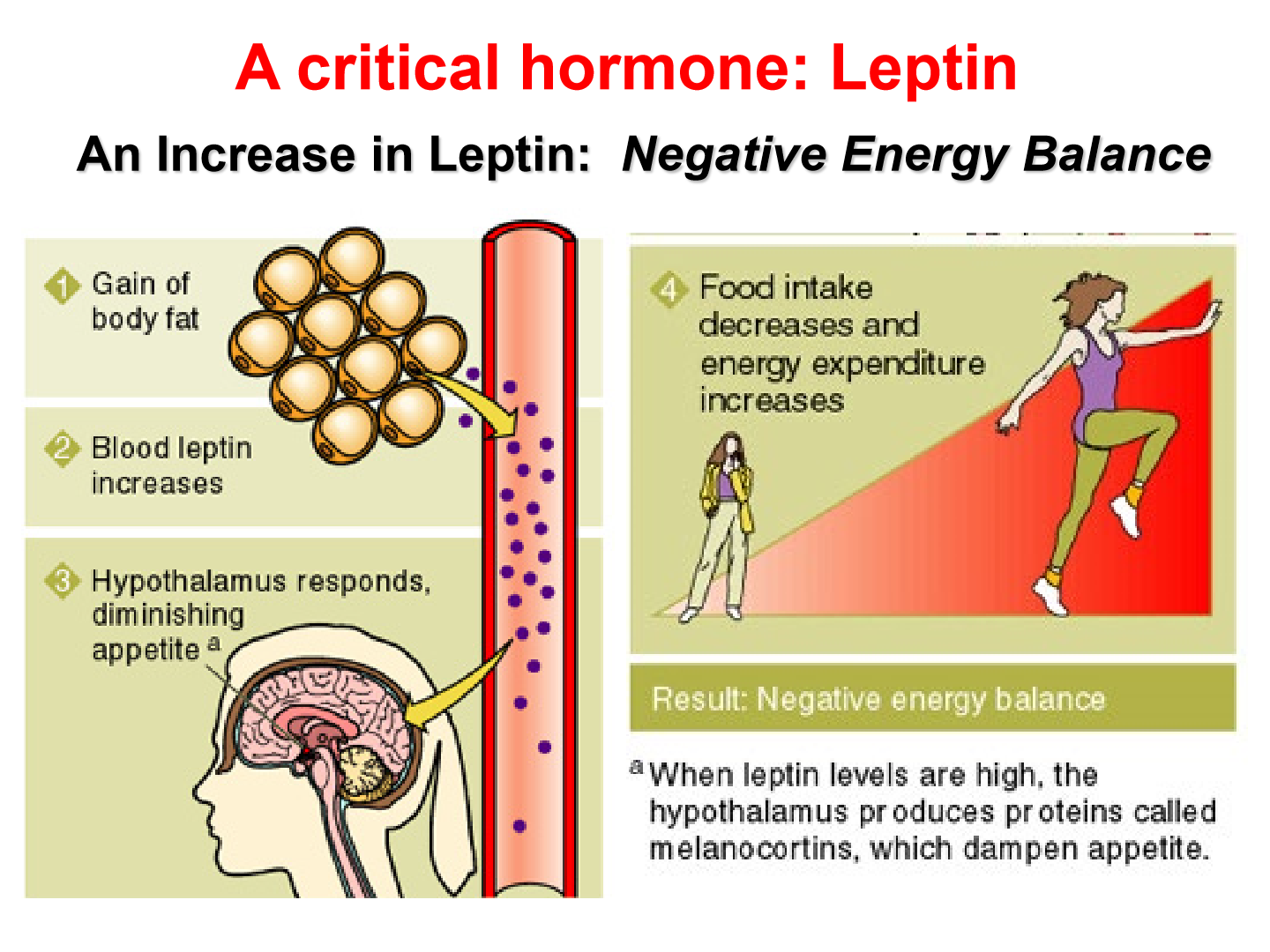
Negative energy balance
- dampens appetite
Gain in body fat = blood leptin increases = hypothalamus decreases appetite
A decrease in leptin

Positive energy balance
- stimulates appetite
Loss in body fat = blood leptin decreases = hypothalamus stimulates appetite
Contrave
– low dose naltrexone (medication used to manage alcohol and opioid dependency) plus bupropion (antidepressant that’s also prescribed for smoking cessation)
– work on two separate areas of the brain that control hunger and cravings
– oral tablet
Saxenda
– GLP-1 (glucagon-like peptide-1) is a satiety hormone found naturally in your body. Acts by decreasing appetite
– prefilled pen that you self-inject
Xenical
– Blocks fat absorption in the intestine, therefore you take in fewer calories
– capsule taken during or just following each main meal
Examples of organized weight-loss programs
Jenny Craig
Weight watchers
Why are diets so unsuccessful?
• They are often hard to follow
• They are often very different from what we are accustomed to
• It’s easy to slip off the diet and “cheat”
• People want a quick fix that works
• Persistent obesity changes the biology of the body
How does obesity create a 'new biology' that Hinders Weight Loss/Maintenance a Full year after significant weight loss?
- Ghrelin - 20% higher (hunger)
- PYY - 20% lower (satiety)
- Body acted as if starving “Post-dieting syndrome”
How does obesity create a 'new biology' that Hinders Weight Loss/Maintenance a Post weight loss?
- Muscle biopsy – burns 20-25% less energy during low-intensity exercise & activities of daily living
- Skeletal muscle work efficiency increased
How does obesity create a 'new biology' that Hinders Weight Loss/Maintenance a following calorie restriction?
- Functional MRI
– activation in the attention and reward regions in response to food
- Caloric deprivation increases the reward value of high-calorie foods more than low-calorie foods
What are some drastic measures of weight loss?
• Prolonged fasting
• Bariatric surgery
• Liposuction
• Each of these carries risks and the latter are expensive
Prolonged Fasting
• Causes “intestinal starvation”
– 50 - 80% of intestinal nutrients are provided by the food we eat
– The balance is provided by the bloodstream
• Mucus and cells are lost from the GI tract linings
• Different from intermittent fasting – latest trend– “In clinical trials, caloric restriction and intermittent fasting result in similar degrees of weight loss and improvement in insulin sensitivity.”
Surgery Pros/cons
Only available to a certain clinical population
• over 18 years old
• BMI > 40 kg/m²
• BMI > 35kg/m² plus 1 or more of high cholesterol, high blood pressure,sleep apnea, diabetes, or joint problems
• have tried different ways to manage weight but it remains high
*Can reduce weight by ~50% and most can maintain the weight loss
- Risks of complications during and after surgery
- Very expensive
4 types of bariatric surgery
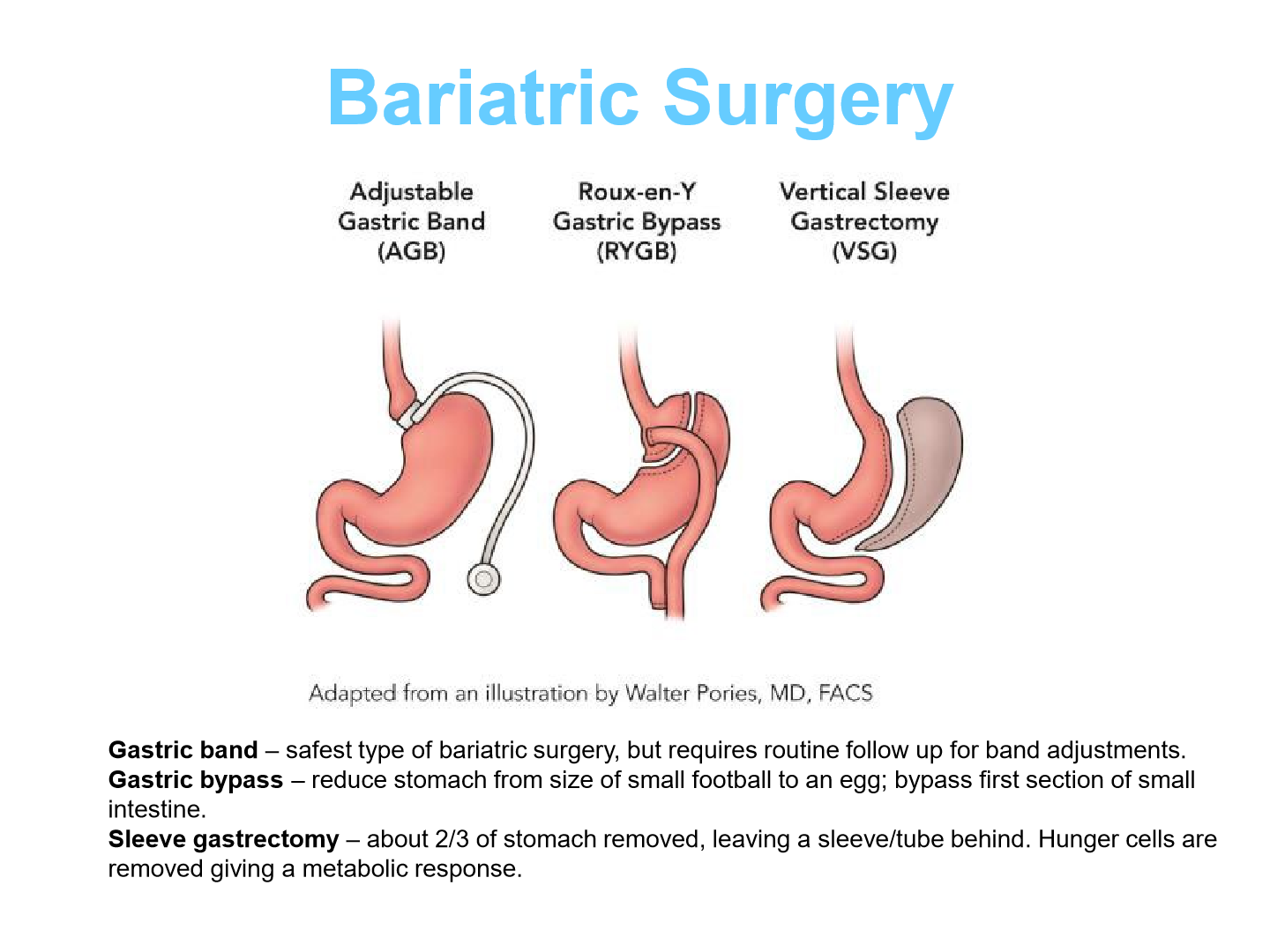
1. Gastric band – safest type of bariatric surgery, but requires routine follow up for band adjustments.
2. Gastric bypass – reduce stomach from size of small football to an egg; bypass first section of small intestine.
3. Sleeve gastrectomy – about 2/3 of stomach removed, leaving a sleeve/tube behind. Hunger cells are removed giving a metabolic response
Rate of success of each bariatric surgery
1. Gastric band – 40% of excess body weight over 24+ months
2. Gastric bypass – 60-85% of excess body weight within 12-18 months
3. Sleeve gastrectomy – 50-80% of excess body weight within 12 months
Liposuction
• Maximum amount of fat removed is 5 litres (about 4.5 kg)
• Cosmetic surgery; not intended for weight loss
• Risks including that your skin may appear bumpy, wavy or withered due to uneven fat removal, poor skin elasticity and unusual healing. These changes may be permanent.
• Liposuction permanently removes fat cells from the targeted areas of the body. So, if you gain weight, the fat will still be stored in different parts of the body.
Those who maintain their weight loss:
• Exercise regularly.
• Make small and comfortable changes in diet and physical activity.
• Eat breakfast.
• Choose low-fat foods.
• Keep track of their weight, dietary intake, and physical activity level.
Those who regain weight:
• Exercise little
• Use popular/fad diets
• Make drastic and unpleasant changes in their diets and physical activity levels
• Take diet supplements
• Cope with problems and stress by eating
National Weight Loss Registry
• Established in 1994 to try to identify behaviors associated with long term weight loss success.
• Largest observational study of weight maintenance and includes individuals who have maintained a weight loss of at least 30 lbs for at least 1 year.
Here are the winning patterns of NWCR members:
• 98% modify their food intake in some permanent way: portion control, low fat diet
• 90% exercise at least 1 hour per day, burning at least 400 calories per session
• 78% eat breakfast every day
• 75% weigh themselves once a week
• 62% watch less than 10 hours of TV per week
• Average daily calorie intake for women = 1306 kcal
• Average daily calorie intake for men = 1685 kcal
Liquid vs. solid food calories
• When people eat calories in the form of solid food, they naturally compensate by reducing the rest of their food intake. But when people ingest liquid calories (alcohol, juice or soda), they don't compensate for them by eating fewer calories.
• The mechanisms controlling hunger and thirst are completely different, and liquids — even if they contain calories — don't seem to satisfy hunger even if they quench your thirst.
• Fluid calories do not hold strong satiety properties. "When the number and type of calories are the same, the calories in liquid form won't suppress ghrelin as effectively as if the same calories were in solid form," says David Cummings, Associate Professor of Medicine at the University of Washington.
• Fortunately, fluids with food in them, such as soups, are very satiating